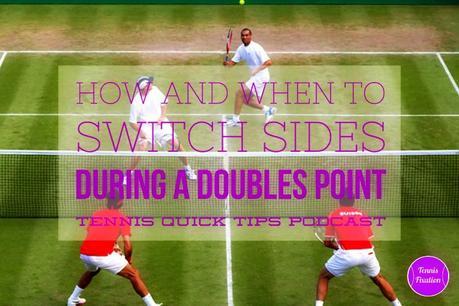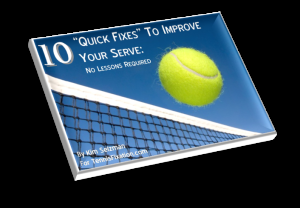Podcast: Play in new window | Download
In doubles, it can get confusing knowing exactly when and how you should switch sides during a point. And this confusion is bad because it can result in leaving huge areas of the court open into which your opponents can easily hit a shot and win the point. So in this episode of Tennis Quick Tips, I'll give you 5 super simple tips to help you know how and when to switch sides during a doubles point. And I'll give you some bonus information on how to get your partner on board with this even if you're playing with a new partner or someone with a reputation for not moving much on court. You can listen to this episode by clicking on the media player above or by listening in with your favorite podcast app. You can also subscribe in iTunes by clicking on this link: tennisfixation.com/itunes.

SHOW NOTES
Today we're going to talk about how and when to switch sides during a doubles point. Now, I'm not talking about switching sides after you play the first set. A lot of times when we play doubles and we lose the first set really badly, we will switch sides with our partner just to try something different. So maybe I start out playing the forehand or deuce side when I'm returning and we lose that first set 6-0 or 6-1 and we decide to change it up. It can't hurt and maybe it will give our opponents a different look and we'll be able to do something better in the second set. No, that's not what I'm talking about.
What I'm talking about is when you actually switch sides of court with your partner during a point, while a point is on-going. And this is an important skill to have and to perform properly because the worst thing you can do in doubles is fail to switch properly and leave a whole side of the court open and allow your opponent to easily win the point by just hitting into the open court.
So let's talk about switching sides during a point, how and when to do it. I've got a couple of tips for you. They're very easy and hopefully you can apply them in your next match.
But before I dive into these, let me just warn you. Doubles is played by two players on a team. Not just you all by yourself. Now if you're listening to this podcast then you're one of those players who is out there trying to improve your game. You're probably in the 1 to 2% of players who is willing to do anything and everything they can do to get better. I'm in that percent and you're in there too if you're listening to this. But you and I are often paired up with people in doubles who don't necessarily pursue the improvement the way that we do. So when I give you these tips just be aware that it takes two people to properly cover the court during a doubles point. And if your partner is not on board with doing it the way I'm describing, with applying these tips because either (A) they've never heard them or (B) they just don't believe they need to change what they're doing, you may have some problems. But I'm going to tell you, after I go through the tips, how you can address that and try to bring your partner on board regardless of whether they are a Tennis Quick Tips listener or not.
So, as I said, the worst thing that can happen in doubles is that you and your partner get confused about who is covering what part of the court and somehow you both end up in the same general area, leaving a great deal of court open and your opponent hits into that open court and easily wins the point. And this is unfortunate because they don't even have to hit a very good shot if you've left the court open or if you've left enough of the court open.
The thing with doubles is you need to constantly be moving, especially when you are up at the net. There isn't going to be a time, and I would say 95% of the time, you are not just standing there watching what's happening. Even if you are not involved in actually hitting the ball at any given moment, you should be moving. Whether that means moving in closer to the net, backing up, moving towards the T to cover the middle of the court. Your feet should always be moving on court during a doubles point.
Now, let's go right into those tips so that you know how and when to make that movement, specifically how and when to make the switch.
1. Get the Full-Court Mindset
What I mean by get the full-court mindset is you and your partner both need to get over thinking that "I'm covering this half of the court and you're covering that half of the court. And anything that goes wrong over there is your problem and your screw-up." You need to get over that. You and your partner and both covering the full court. There are parts of the court that it may be easier for you to get to at any moment than your partner, but basically no one has a side. You need to be ready and able to move around and take over the other side at any time if that's what it takes to get to the ball and hopefully win the point. So do not adopt that "I'm playing the deuce court and you're playing the ad court side" mindset. Be ready to move to any part of the court if that is what it takes to get to the ball.
And this is where I'm saying, your partner may not be on board with this. You may have a partner who's like "that's your side over there, I'm covering this side, I'm not responsible for what's happening on your side and (and this is the danger) don't you come on my side and try to take my balls." That can be a problem because there will be balls that will be on your partner's side that they cannot get to and that you need to take. A great example that I bet we all see in almost every single match is the lob that goes up over our partner's head when our partner is at the net. Often, these high, deep lobs that go up and over our partner's head, we've got to run back and run those down and that means switching sides of court. So there's a good example right there of when you would take over that other side of the court that's supposedly your partner's side. You need to be willing to do that and your partner needs to be willing to not only let you do that, but be ready to do the same thing - run down the balls that are up and over your head.
Hopefully you can get your partner on board with that and I'll tell you, at the end, some things that I think can get your partner there.
2. Call the Ball and Respect the Call
Probably the biggest problem that we have in court coverage in doubles is nobody calls the ball. This happens a lot. And I'm not sure if people are being polite, because they don't want to yell at their partner, or if it's more of a late decision to understand that it's your ball and you're going to take it and you need to call it. You need to be way more willing to make those calls even if you're calling balls that you think, "Well, this is obviously my ball. There's my need for me to call it." Get yourself into the habit of calling those balls anyway. And calling the ball may mean saying, "Mine" or "I got it." It may mean saying "Your's" to your partner. It may mean saying, "Switch." This is because this means you're taking a ball that is on your partner's side of the court or you want your partner to take a ball and you're calling for the switch because it's obvious to you that you can't get it and your partner needs to get that ball. A good example of that, again, would be the lob that goes over your head when you're up at the net and your partner's back. You need your partner to run that down. And you can signal this by saying "Your's" or even by saying "Switch" so that your partner knows that you're moving too. Not only are you expecting them to take the ball, but you are crossing to the other side so they need to switch and stay when they do make that switch.
The other part of this, not just calling the ball, is to respect the call. Often, you call a ball and you say, "Your's." You don't think you're going to be able to get to it and you're giving it to your partner. But then you realize you can get to it. You think you can make a pretty good shot here. This might be the lob that goes up over your head that you now realize isn't going as deep as you thought and you can take it out of the air as an overhead. But you've already said, "Your's" or "Switch" and your partner's running that ball down. In that situation, you've got to stay with the call. Similarly, if your partner calls a ball that you think you could get to it anyway, you've got to stay with the call. If you don't respect the call, if you go against it and try to change what's happening on court, your partner is going to get confused and may end up leaving half the court open because now you're taking that short lob as an overhead. They're running back for it because you said, "Your's." You're both on the same side of court and you've left half the court open for your opponents to hit into.
Bottom line - whoever makes a call on court, respect that call and go with it. Don't spend time second-guessing it or analyzing whether you've got a better play on the ball than your partner who has called it. Respect the call and follow through so that you have the court covered and you're not leaving half the court open for your opponents.
3. When Your Cross the Middle, Just Keep Going
This is especially true when you're poaching. I do this. I see other people do this all the time. And this is not the way to poach. When you go for the poach you need to keep moving to the other side of the court. So imagine that you're up at the net on the deuce side and you're going to poach the return that's coming across the net towards the middle. So you're moving towards the ad side of the court to make the poach. You've got to keep going.
For one thing, if your partner is looking at you is seeing you poach and should be moving behind you to take your place. For another thing, your momentum is carrying you towards that ad side of the court. So you need to follow through with that and not try to stop short and move back to your original position. It confuses your partner and it takes the momentum out of what you're doing. Let your momentum carry you into the other court.
So once you've made that crossing motion over the middle of the court, just keep crossing.
Let me just say, this is usually true. Nine times out of ten I'm guessing. There may be situations where it doesn't work out that that's the best thing to do, especially if it's happening back at the baseline and you've got more time. But when you're up at the net and you're moving across the middle of the court, just keep on moving.
4. Watch the Player Who Is in Front of You
If you're playing back, or if you're at the net and you're behind your partner, watch what your partner is doing and compensate for that. Make the logical movement to change position even if they don't call for it, based on what they're doing. And back to the poaching example, if you see your partner poaching, you need to assume that they are going to continue crossing and you need to cross behind them and cover that other half of the court. So, if your partner is in the deuce court and they poach and are moving to the ad court, you have to assume that they are going to continue into the ad court and now you are going to move over and cover the deuce court because now that's open. So when you are behind your partner, and you might be at the baseline or you might be up at the net but they're just a little bit in front of you, you need to keep your eyes not just on your opponents and the ball, but also have your partner there in the corner of your eye. Watch what they're doing so that you can switch if necessary.
5. Listen to the Player Who Is Behind You
If you are that player up at the net, you can't turn around and see what your partner is doing. You have to keep your eyes forward watching your opponents to see their reactions. But you can listen to what's happening. You can hear your partner running things down. You can hear them when they hit the ball. You can hear them when they make the call for you to switch or take the ball or whatever they want you to do. Use your ears to help you know, when you can't see your partner, what you need to be doing, whether you need to switch to the other side of the court based on your partner's actions.
Now let's talk about how you're going to convince your partner to go along with all of this. Maybe you have someone you've never played with before. Or you are playing with someone who you are well aware that they are not going to be moving around a lot.
What I usually do is, when I come on court with someone that I'm playing with for the first time or someone that I know has a reputation as not being much of a mover, I will say to them, "Hey, just so you know, I talk a lot out on court. I will call the ball a lot. I hope it doesn't bother you but it helps me and so just be ready when I'm telling you that I'm taking the ball or I'm giving it to you if I say Your's or Switch, that's me and that's what I do. And I think it will help us play better together if we're communicating with each other." So that's what I do before we even start playing.
And then, during my match, I will be sure and let my partner know when we do make switches and call the balls, how helpful that was, by saying things like "Good call" or "I'm glad you told me to switch." Whatever I can do to reinforce how helpful that stuff is. So those are the things I try to do with people when I'm not 100% sure that they're going to be on board with all of this switching.
SHARE, SUBSCRIBE AND REVIEW
If you want to make sure you never miss an episode, it's easy to subscribe! Just click on one of the buttons below:


You can also get the direct RSS feed for your own favorite RSS Podcast Player by clicking here: Tennis Quick Tips Podcast RSS Feed.
And if you'd like to become a friend of the show, please leave an honest review on iTunes by clicking here: Tennis Quick Tips Podcast iTunes Page. It will help the show become more easily discovered by like-minded, awesome people just like you. I appreciate it!
Looking for a specific episode? All of the Tennis Quick Tips podcast episodes are listed on the Tennis Quick Tips Podcast page. Just click here to find what you're looking for: Tennis Quick Tips Podcast.
BUILD YOUR TENNIS FITNESS AND ENDURANCE
If you're really interested in building your endurance and fitness for tennis, I know you'll like my very first tennis mini-course, Simple Endurance Training for Tennis. For more information or to join the course, just click on the image below or visit: http://tennisfixation.com/endurance.

GET A BETTER SERVE FAST!
And if you're interested in getting a better serve - fast! - get my free ebook, 10 Quick Fixes to Improve Your Serve: No Lessons Required.

By applying the 10 simple tips to your serve that I give in this ebook, your serve can become a tool that you can use to gain control of points. It can become more powerful, more accurate, and something you're actually proud of. Just enter your email below and you'll get instant access to this free ebook as well as weekly updates with all of my best tennis tips!

© Kim Selzman 2016 All Rights Reserved

